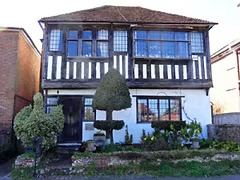A Short History

Once a coastal town and port with river access inland, the Domesday Book of 1086 describes Appledore as having a church and six fisheries. The Romans passed by in the 1st century AD and encamped on Oxney where they left their alter to Mithras.
In early mediaeval times Appledore had a port on the river Rother and the status of a town with a market and an annual fair. Following the silting and eventual diversion of the river during the 13th Century, Appledore retained importance from being located on relatively healthy higher ground than the adjoining Romney Marsh. The Royal Military Canal, built in 1804, as a precaution against a further French, (Napoleonic), invasion runs through the edge of the village.
Today the population of Appledore and Appledore Heath is in the region of 800. The village has an Ancient Church, Methodist Chapel, a Village Hall and a Recreation Ground. Farming is the principle activity of the surrounding area, but the residents of the village work across a broad spectrum of professions from agriculture to engineering, financial services, the arts and service industries. The village is also home to one of the most highly regarded vineyards in England.